We’ve all been told to “sneeze into our elbows” to prevent other people from getting sick. Most of us still remember the feeling of being in lockdown at the height of the COVID-19 pandemic, watching the number of cases exponentially increase. But how does this work? How does infectious disease get around?
Welcome to this guide on Module 7 Biology, which is all about infectious plant and animal diseases! Today we’re going to be giving a taster on Infectious Diseases as part of the HSC Biology course. We’re going to explore different modes of disease transmission, and our body’s response to it. We’ll also look into immunity, prevention, treatment, and control of diseases.
The goal of this article is to break down the key concepts taught within Module 7, share tips that will help you score a Band 6, and show you some sample responses!
Key Concepts
Modes of transmission of infectious disease
Understanding how infectious diseases can be transmitted is super important! Let’s start with a definition. In this case, transmission of a disease refers to the transfer of a pathogen from an infected host to a non-infected individual.
Over time, infectious diseases have evolved to varying degrees under different selective pressures and can thus ‘survive’ outside of their host (e.g. a human) for differing periods of time. This has led to multiple different modes of transmission that are all dependent on a pathogen’s ability to survive outside the host organism. They’re split primarily into two categories:
Direct contact transmission refers to infectious diseases spread via physical contact between an infected host and another human, by transferring the pathogen. This includes person-to-person contact, leading to the exchange of bodily fluids. This also includes the spread of respiratory droplets or “airborne transmission” - for instance in influenza virus, when an infected person coughs or sneezes, dispersing infected particles that are then inhaled by a non-infected person. This is why you’re told to cough or sneeze into your elbows!
Note: Viruses are predominantly spread through direct contact as they are unable to replicate outside the host cells, and thus have a short life span outside the body.
Indirect contact, on the other hand, does not involve physical contact between two organisms. Instead, in indirect transmission, the infectious disease is spread via another intermediate object. This encompasses contaminated food and drinking water, animal-to-human contact such as a scratch or bite, and medical equipment (e.g. unhygienic needles). This also includes vector borne diseases, which refer to the spread of infectious disease via infected arthropods (e.g. malaria, which is spread by mosquitos).
Phagocytosis and The Third Line of Defense
The first, second, and third line of defense in your body can be broken down as follows:
-
First line - the physical outer barriers against entry to the body such as your skin.
-
Second line - innate immunity present from birth, triggering a non-specific response against the invader. This is where phagocytosis occurs (more on this later).
-
Third line - an specific immune system response, acquired after previous encounters with a particular pathogen.
Let’s explain the second line a bit further. Phagocytes are a type of cell that protect the body by ingesting and eliminating harmful foreign particles, bacteria, and dead or dying cells. These include Macrophages, Neutrophils, and Dendritic cells. These cells, along with the help of B and T cells, are responsible for what’s known as phagocytosis. So then, time for a definition and a quick, simple explanation.
Phagocytosis is a cellular process for ingesting and eliminating particles larger than 0.5 μm in diameter, including microorganisms, foreign substances, and apoptotic cells. It is considered one of the most important parts of the immune system.
How does phagocytosis work?
-
Phagocyte detects a pathogen by recognising a pathogen-associated molecular pattern.
-
Phagocyte adheres to the foreign cell and engulfs it through infolding the cell membrane
-
Pathogen is trapped inside the vacuole, which is now known as a phagosome.
-
Lysosomes fuse with the phagosome and release their rich digestive enzymes into the phagosome to ‘digest’ the pathogen.
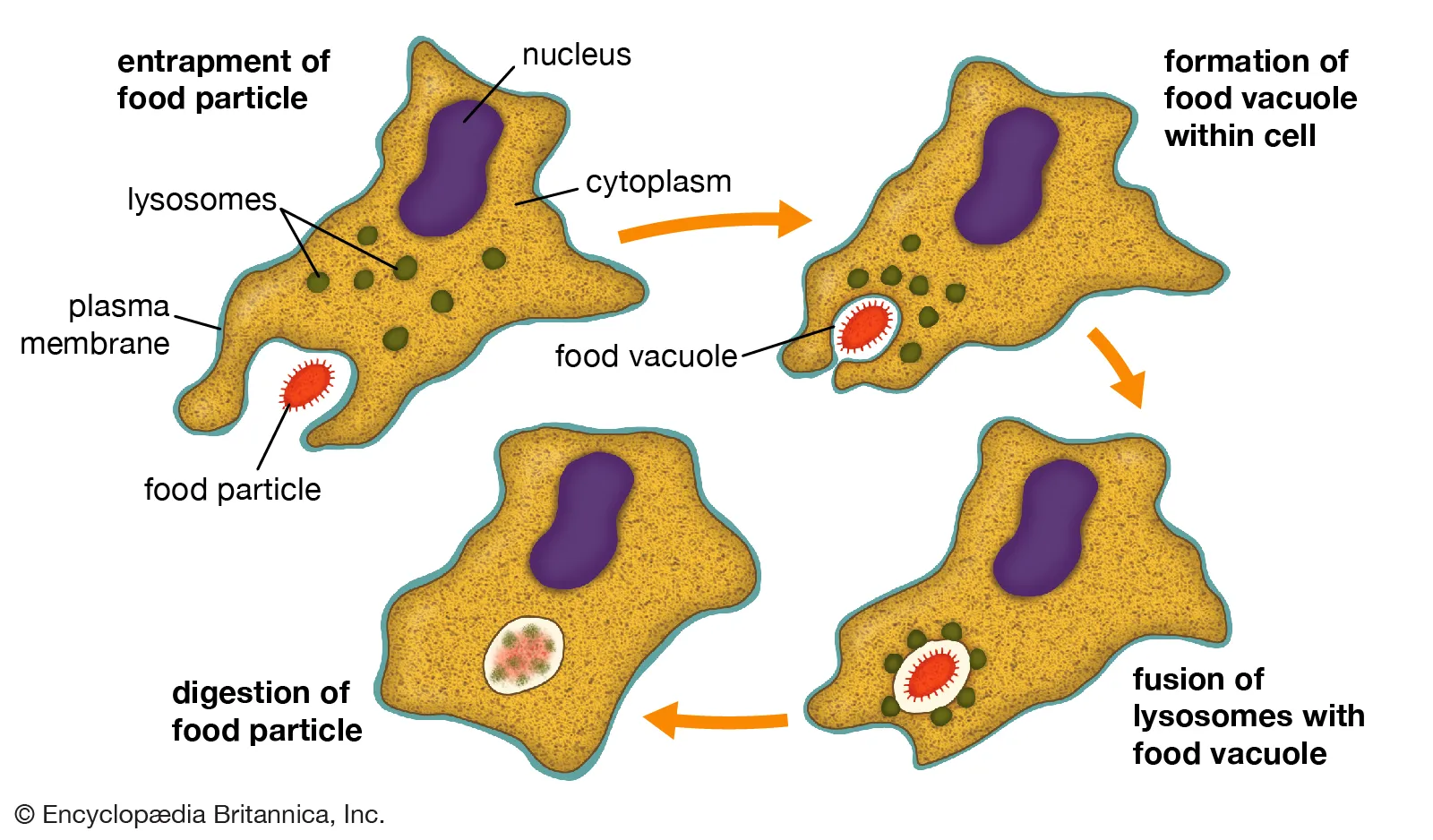


The process of phagocytosis, as depicted by Encyclopaedia Britannica.
As mentioned before, acquired immunity (third line of defence) occurs after exposure to a pathogen. This involves the production of specialised cells to combat specific antigens: antibodies. These cells are created by activated B-cells that turned into plasma cells.
The activation and differentiation into antibody-secreting plasma cells requires two signals. The first signal is derived from the binding of an antigen to a B-cell, and the second signal can be delivered by a T-cell. The antibodies created in this third line of defense effectively blocking the entry of a pathogen into a cell. Why is this important? The pathogen is now:
-
Unable to infect healthy cells.
-
Unable to replicate itself and cause severe infection.
Prevention, treatment, and control of infectious disease
So what happens if all of our lines of defence fail, and we get sick? What happens if we get someone else sick?
This last concept focuses on diseases transmitted throughout a population, leading to epidemic (local) or pandemic (global) events. For example, the COVID-19 pandemic. Scientists constantly study and surveillance of emerging and re-emerging diseases. By analysing incidence and prevalence rates of disease, they can find ways to predict, prevent and respond to outbreaks of disease. Something important to note is that as our collective understanding of science and infectious disease improves, we’ve also gotten better at disease management.
So, what are some of the ways of controlling the spread of infectious disease?
Hygiene practices
-
Personal hygiene – pathogens require the right conditions to continue to survive and proliferate, hence cleanliness limits spread.
-
For example, handwashing, body and hair washing thoroughly and frequently, especially after encountering dirty objects or an infectious agent.
-
Avoid coughing or sneezing on others to reduce airborne transmission.
-
Avoid sharing food or items such as lipstick with others.
-
-
Government regulations of public services prevents occurrence of infectious disease and controlling disease outbreak. For example:
-
Collecting and disposing of sewage, household, medical and industrial waste,
-
Providing clean water - water supplies should be filtered, chlorinated, frequently tested
-
In emergency events, establish temporary infrastructure ASAP, such as portable
-
toilets, rubbish containers, water purification, and bottled water.
-
-
Safe food practices – infections spreads easily when food is contaminated by pathogens. Therefore, it is important to:
-
Hand washing frequently before and during food preparation.
-
Food-handling gloves.
-
Covering any wounds before handling food
-
Quarantining
Quarantine refers to a period of isolation used to prevent the spread of infectious diseases. Measures include isolation or hospitalisation of infected people, border screening to limit the spread of infectious disease, collection of passenger/cargo information, etc.
Vaccinations
Arguably one of the most effective measures in preventing future infections, immunisation/vaccination programs aim to decrease incidence of many diseases, and ultimately eradicating them. This builds on the concept immunity that we discussed earlier! Vaccines essentially train your body to prevent falling sick to an infectious disease, by introducing antigens into the body, mimicking an infection and letting your immune system practice responding.
Vaccinations are particularly important for someone who is a “susceptible host”, meaning they are a person-at-risk of contracting infectious diseases. For example, babies, healthcare workers, or those who are immunocompromised.
The more people who are vaccinated, the less chance of spreading the infectious agent (since there fewer potential carriers of the infectious disease). This is referred to as “herd immunity”.
Need extra help understanding the theory? If you’re enrolled in Project Academy’s HSC Biology Course, you will get access to detailed notes written by high-scoring tutors, including more sample questions that you can use to strengthen your fundamentals!
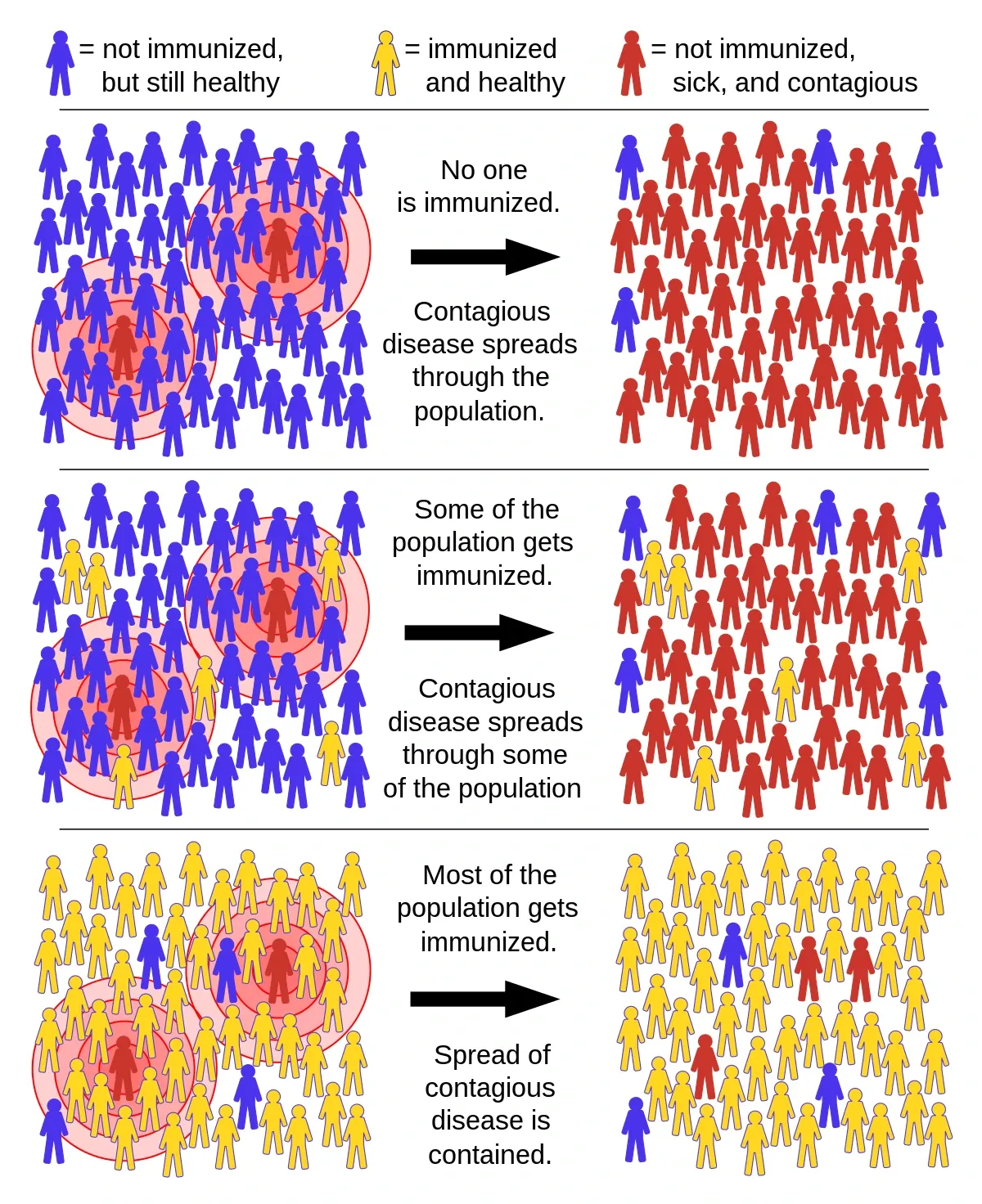


The process of herd immunity. Image credit: Wikipedia.
Tips to ace this module
Confidently navigating the HSC Biology Syllabus
When it comes to acing HSC Biology, think of the syllabus as your trusty sidekick. It’s like having a GPS! Many students underestimate just how powerful the syllabus is. Each dot point in the syllabus outlines specific knowledge and skills you need to master for the exam. NESA can only ask you what’s in the syllabus, so knowing the syllabus inside out effectively means you could never be caught off guard.
One nice hack is simply to structure your study notes underneath the corresponding syllabus dot point. That way, you have a fleshed out set of notes that address everything you need to know. For example:
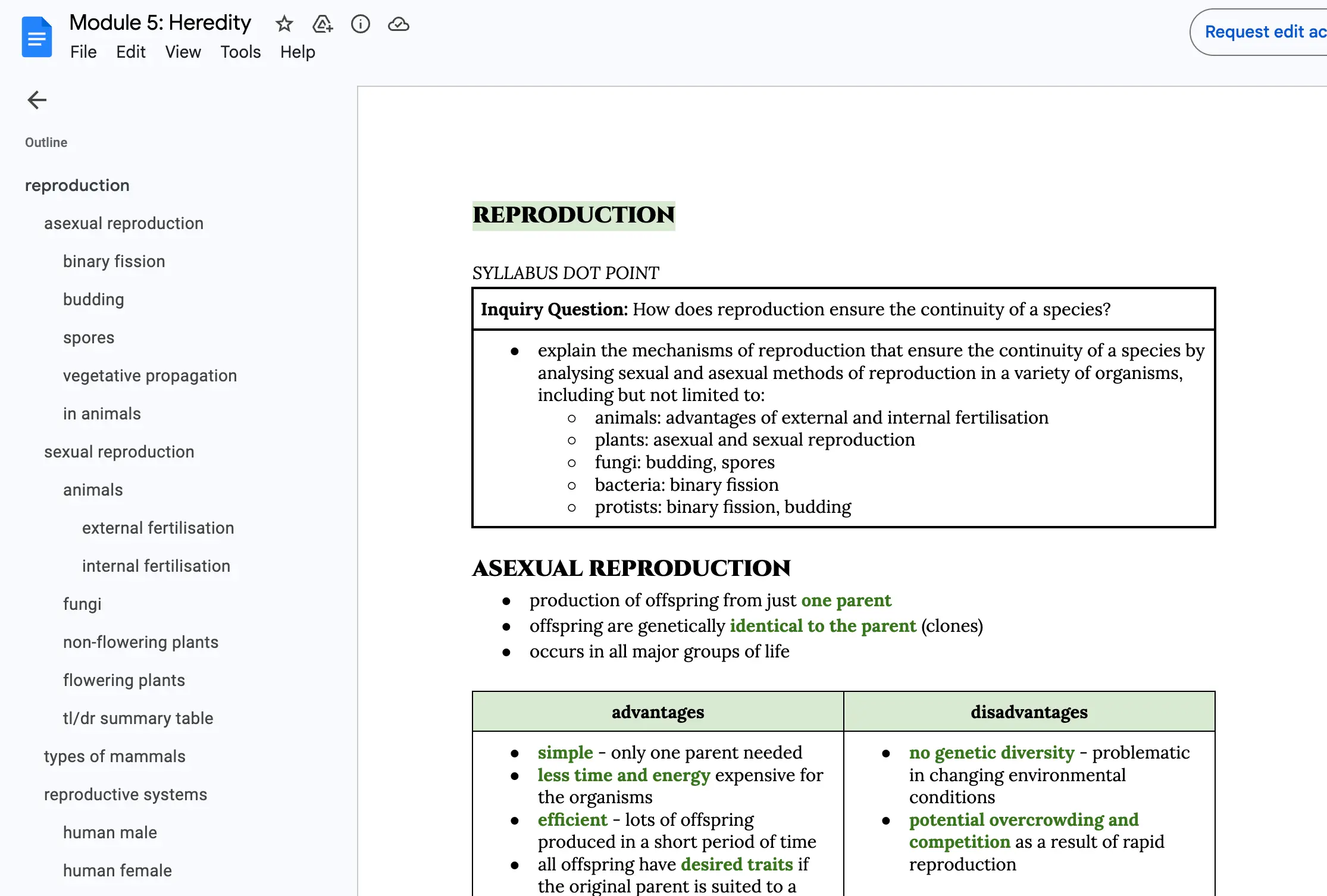


For more tips, check out “How to Write the Most Effective Set of HSC Study Notes”!
Being familiar with Biology Module 7 jargon
As you may have noticed, this module is jam-packed with words and definitions. A key skill to do well in your assessments, is having all the definitions memorised and being able to refer to them in your extended responses. Here we break down some of the key ones:
-
Immune system: refers to a complex network of organs, cells and proteins that defends the body against infection, whilst protecting the body’s own cells.
-
Pathogen: defined as an organism causing disease to its host
-
First Line of Defence: refers to the initial and innate barriers to entry against pathogens. This includes skin, mucous membranes, stomach acid, oils on skin
-
Second Line of Defence: innate immunity that occurs once a pathogen or foreign substance breaches physical barriers to entry of the host. This includes inflammation and phagocytosis.
-
Phagocytosis: refers to cellular process for ingesting and eliminating particles larger than 0.5 μm in diameter, including microorganisms, foreign substances, and apoptotic cells.
-
Phagocytes: refers to the cells responsible for carrying out phagocytosis
-
Macrophage: refers to type of white blood cell that surrounds and kills microorganisms, removes dead cells, and stimulates the action of other immune system cells
-
Neutrophils: refers to one of the first immune cells to respond. They travel to the site of infection, where they destroy the microorganisms by ingesting them and releasing enzymes that kill them. Neutrophils will kill themselves after a certain time as they are ‘too dangerous’ and can harm the host’s healthy cells.
-
Dendritic cells: not to be confused with dendrites, these play no role in the nervous system and plays the same role as macrophages.
-
Major Histocompatability Complex (MHC): refers to a group of genes that code for proteins found on the surfaces of cells that help the immune system recognize foreign substances.
-
MHC-I: defined as a class of MHC, which is exposed on all cells when “shady” molecules are produced inside of the cell. An example of this is seen on cancer cells, where on it’s MHC-I, will show mutated/ harmful peptide chains on the cells membrane. This will later will be dealt with by cytotoxic T-cells.
-
MHC-II: defined as a class of MHC, which is exposed on cell membranes after a pathogen has been ingested from the outside of the host cell. The resulting peptides after the pathogen has been digested will be presented on the cells membrane via a MHC-II complex. This will be recognised by naive B and T cells that will later trigger an adaptive immune response.
-
Lymphocyte: defined as a subset of leukocytes, including B and T cells.
-
Naive B Cell: defined as a B cell that has not been exposed to an antigen. These develop in the bone marrow.
-
Effector B cell: defined as a b cell that, once activated by interacting with the complementary antigen and the helper T cell, proliferate into plasma cells responsible for antibody production.
-
Memory B cell: refers to a b cell whereby their role is to remember the antigen so your immune system can quickly identify and fight it in the future. These lymphocytes stick around for a long time (can last decades), and do not trigger cell death to protect the body against infection.
-
Antibodies: refers to a protein component of the immune system that circulates in the blood, recognizes foreign substances like bacteria and viruses, and neutralizes them
-
Naive T Cell: defined as immature and, unlike activated or memory T cells, has not encountered its cognate antigen.
-
Helper T Cell/ CD4+ effector T cells: defined as a type of immune cell that stimulates killer T cells, macrophages, and B cells to make immune responses.
-
Cytotoxic T cells: refers to a type of immune cell that can kill certain cells, including foreign cells, cancer cells, and cells infected with a virus.
-
Third Line of Defence: defined as immune cells that target specific antigens. The immune cells that play a role in the third line of defense are B-cells and T-cells, both are white blood cells.
Doing as many practice questions as possible
“Cool. So I’ve studied according to the syllabus and learnt all the jargon, but I’m still not confident for my exams, I mean seriously what do I have to do?!”
Good question. But, the secret is surprisingly not as secret as it seems! It’s all about application from here. Focus on active recall, whether that be teaching another student, drawing mind maps, doing past paper questions etc. For more inspiration on how to revise throughout HSC, check out “How to study for HSC: Constructing Study Habits”.
PS: Project Academy’s HSC Biology Program also gives you access to a huge variety of practice questions. Their “Books” and “Library” apps are home to thousands of past exam questions, allowing you to test yourself!
Sample Multiple Choice Question
So, let’s put some of our knowledge into practice, and see how it plays out. When it comes to MCQs teachers have always pushed the process of deduction to find the correct answer. I wholeheartedly agree with this, if you can reduce your choices as much as possible, you’ll get much closer to finding the answer AND you’ll be able to pick up on sly tricks the question might be throwing at you.
2019 HSC Biology Exam - Question 4
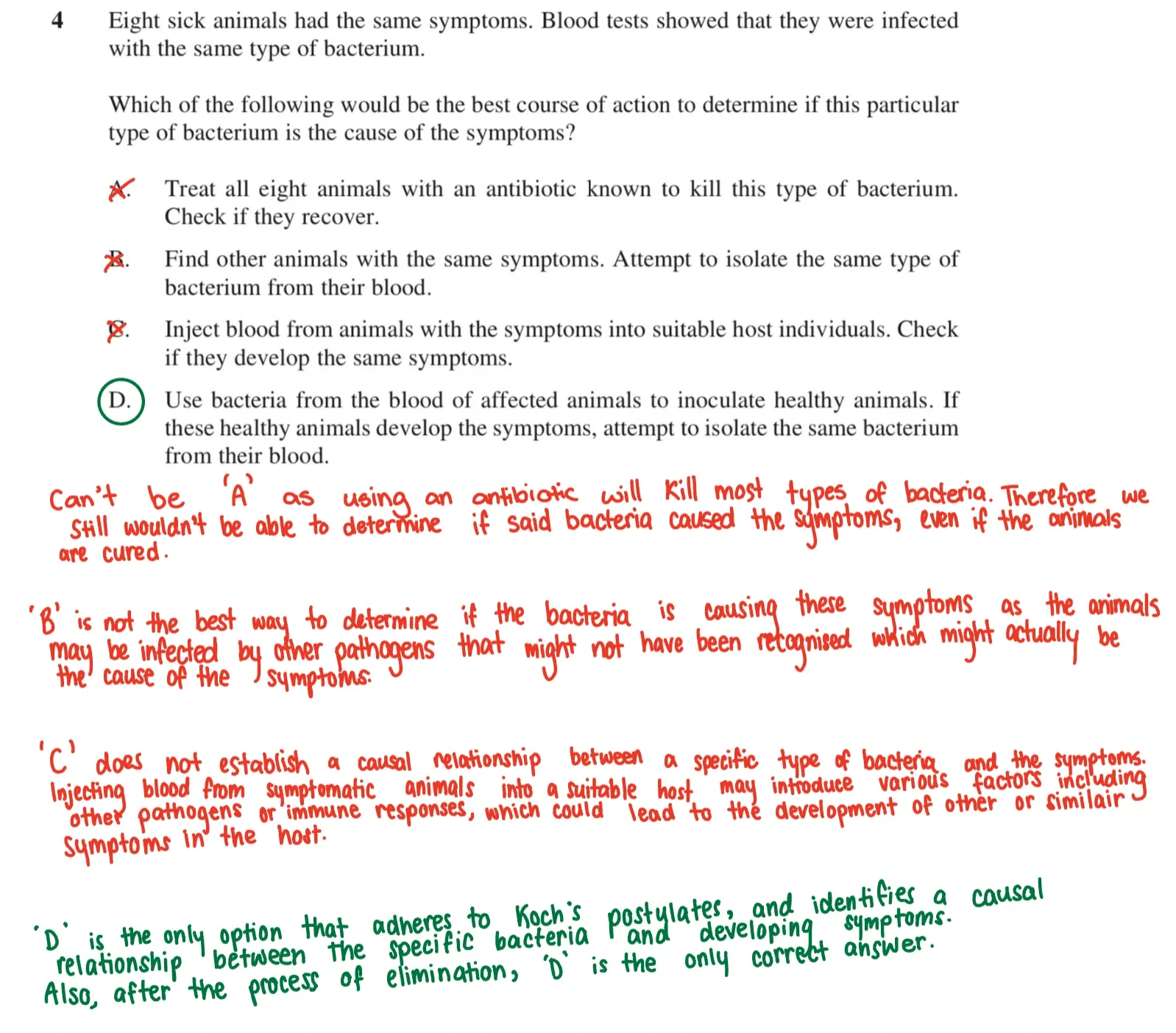


Sample Extended Response Question
When it comes to extended response questions, it is important to:
-
Pay attention to the directive verb of the question. An “explain” question will require different things compared to a “describe” question. For more details, check out our guide “The Ultimate Guide on HSC Verbs”.
-
Pay attention to the mark allocation - this usually indicates how much you should be writing, and the depth of detail you should aim for.
-
Define any key terminology at the start of the question.
-
If asked for examples or case studies, refer to ones you found from textbooks, school, or personal research.
-
Include the scientific names of relevant organisms where possible.
Here’s an example, colour-coordinated so you can see how it all works.
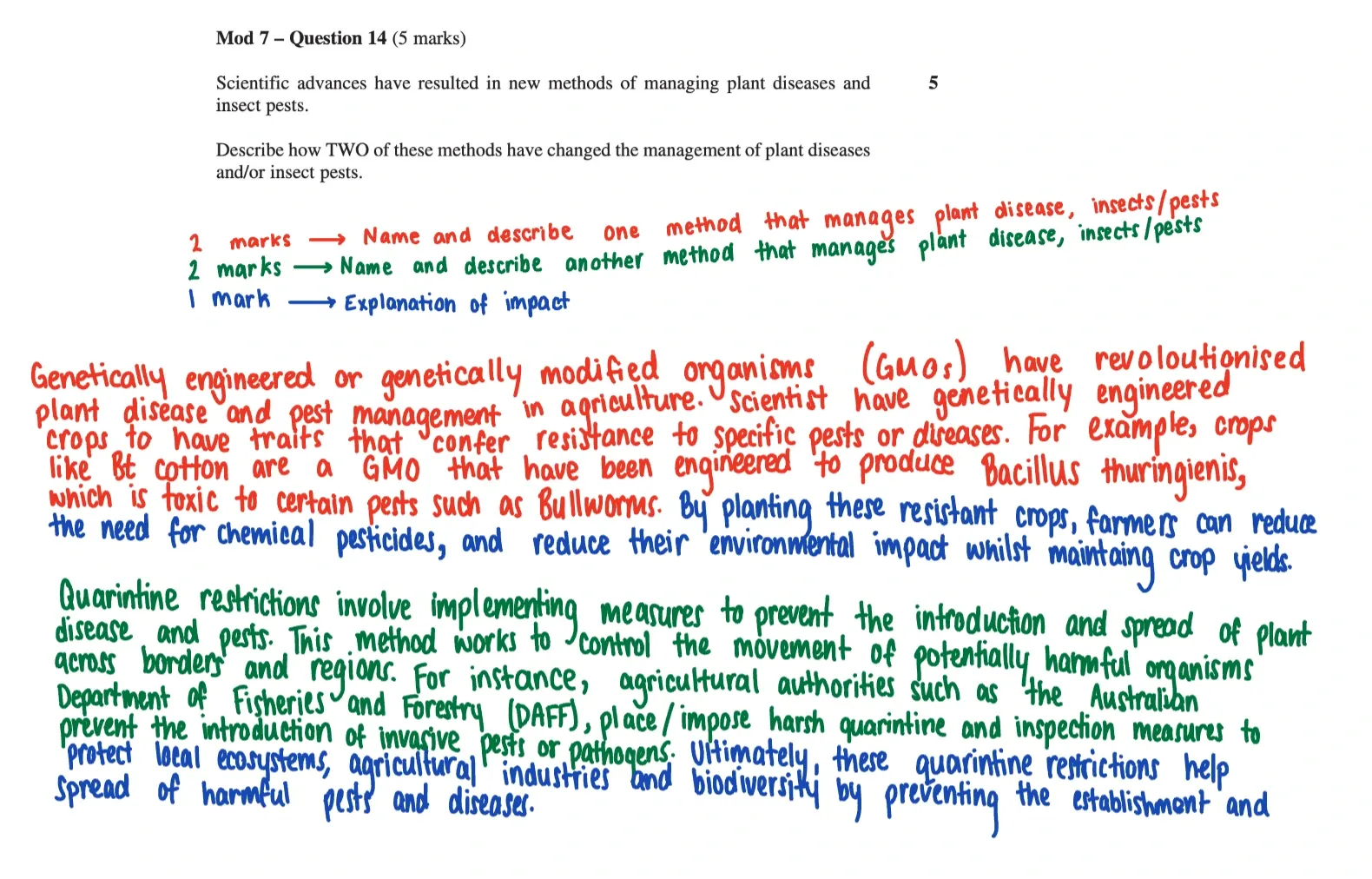


Conclusion
And that’s it! Thanks for reading along on this guide for module 7 biology.
Remember to take it slow, break the content down into bite-sized pieces and cross-reference with the syllabus. Finally, practice applying the concepts, and you’ll be fine! All the best :)
Looking for some extra help to ace HSC Biology? Look no further. At Project Academy, we proudly use a proven approach involving weekly masterclasses, personalised tutorials, comprehensive notes, daily support (online and offline), and more! Find out more here.









